If you are into skinning cats, you will find that there are more ways to get racecars around corners than there are cats to skin. On the other hand, skins on racecars are what connect your secret set up to the ground. More adhesion at the contact patch creates long lasting speed. Balancing the grip at all 4 corners produces a fast car and any talk of skins can be limited to tires – you can leave the cat lady alone. Maintaining desired tire size is critical when it comes to being catty enough to win.
Bias Ply Tires
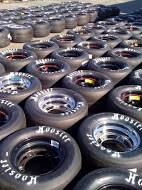 Managing tires can be a daunting task. Keeping good notes and having the proper tools for measuring and purging saves valuable time and is often the difference that gets your team the big win.
Managing tires can be a daunting task. Keeping good notes and having the proper tools for measuring and purging saves valuable time and is often the difference that gets your team the big win.
Bias Ply tires (radials are a different animal) require constant care to minimize variables. Maintaining the desired size and air pressure is an art. With a little care and a repeatable routine, tire sizes can be managed preventing erratic growth changes. Prevention and a dedicated tire specialist is often the team component that keeps your car in the front. Maintaining a consistent approach to tire preparation is what allows you to land on all fours regardless of track conditions.
The goal is to keep the tires the tires sized properly avoiding unpredictable growth. Variables can be controlled or at least reduced. Starting with tires that are manufactured to the desired size is a best practice. Attempting to change a tire size by artificially stretching it with added air pressure is a sure way to produce false sizing numbers that change at the first heat cycle. A good racecar goes to junk if stagger changes in an unpredictable fashion.
Tire Roller
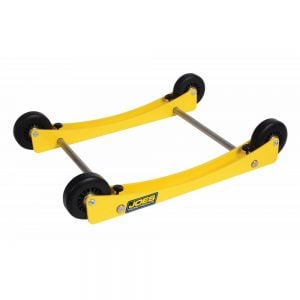 Using a tire roller helps to measure stagger (roll out) quickly making quick work out of your tire stack adjustments.
Using a tire roller helps to measure stagger (roll out) quickly making quick work out of your tire stack adjustments.
For bias ply tires my general rule of thumb is to use a maximum of 2 pounds of pressure to increase or decrease the size of the right size tires from my optimal pressure. Any pressure beyond 2 pounds, above or below, the ideal right side tire pressure changes the spring rate, camber temps, and tire foot print potentially reducing speed. For left side pressures, I might allow a 3 pound variance but since we tend to run such low pressures on the left side use caution to avoid crossing over the minimum pressure line. Buy the tires at the right size. Spend the time to remount tires that are the correct size.
Tire Tape Measure
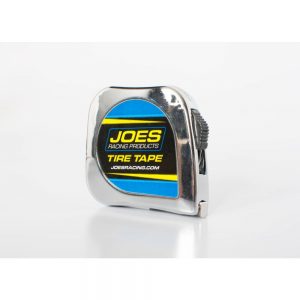 A 1/4″ Stagger tape, used with a tire roller, gives you price readings. Be sure that your tape remains exactly straight and true on the tire.
A 1/4″ Stagger tape, used with a tire roller, gives you price readings. Be sure that your tape remains exactly straight and true on the tire.
There is debate on how much bias ply pressure variance you can utilize to get to your optimal stagger. For this article we are focusing on bias ply – it is well known the radial tires are extremely sensitive to pressure changes and even quarter pound pressure adjustments can be dramatic with radials.
Dave Juarez, the tire specialist at Gene Price Motorsports for the #26 Greg Pursley driven K&N Pro Series West team says, “with bias ply I can get away with 3 to 5 pounds of added pressure without adverse affect. For qualifying, 5 added pounds frees up the car and helps to build heat quickly”.
Growing tires is a bit of a myth. Sure, you can change the size with more pressure but making a tire bigger by stretching it only gains a small amount and that growth is often inconsistent. Dave Juarez says, “filling a tire to 50 PSI and letting it sit in the hot sun can make it stretch. Generally, a heat cycle is needed to keep the tire at the desired size”.
A common mistake I have seen with bias ply tires is that teams over fill tires to “stretch” them in an effort to grow the tires to get more stagger. These teams overfill the tires and then quickly drain the air down to race or practice pressure and take a measurement. This method always ends up with false size readings. As soon as the tire heats up, the artificial “stretched” reading disappears and the tire shrinks back to near its original size. You might grow the tire a fractional amount but if you were counting on the extra stagger to get through the center you can be assured that the tire size will change at race temperature.
Championship driver and JOES Racing Products owner Joe Constance says, “2 pounds of variance is ok to get stagger, 2 more PSI in the rights and 2 less PSI in the works fine but any more pressure change than that and you are fighting evil with evil.
I have seen all kinds of tricks to change tire sizes. Over filling tires and bouncing them like a basketball to gain size. I have seen teams run too much air pressure in practice to help grow tires with a heat cycle – go too far and you risk cooking cooks the tire center. I have seen teams try to shrink left side draining them of air after a heat cycle and then dousing them with cold water. This method can harden the tire and rarely has much sizing benefit. It is tough to change once a tire is manufactured. Adding pressure or dropping pressure will get you a size change but really the size is determined at the time of manufacture.
Juarez says, “I have bounced tires also but it is a desperate last resort. You might be stretching the center of the tire but I wonder what is happening to the contact patch? It is hard to stretch a tire at the side walls. I still think you get what you get and after one or two heat cycles just count on tires being about that you originally measured. I have had tires stretch or even shrink during a race but it is out of your control. Just be very consistent with the way you prep your tires and you get a pretty good feel for what they are going to do”.
Dave Juarez states, “if you get a heat cycle on a tire and quickly drain the hot air and replace it with cold nitrogen the second the car comes off the track you can make the tire a little smaller or at least keep it from growing more”. Dave continues, “Adding nitrogen to a hot tire can help it to grow but not all that much”.
Joe Constance says, “I never had any luck stretching tires on my Saturday night racing. I like to put 30 psi in the lefts and 50 in the rights and leave them for 30 minutes to let them get a set when they are new. After you put a heat cycle in them you get what you get. You can make them bigger or smaller with air pressure but you need the right size tire with the right pressure to be fast”.
Using nitrogen instead of compressed air helps with consistency. Nitrogen is nearly moisture free and air from a compressor contains moisture. You get moisture in the actual air but you can also get a lot of vapor from the compressor tank and lines. Moisture inside the tires creates added heat expansion and if any tire contains more moisture than the others in the set then stagger changes unpredictably.
Purge Tool
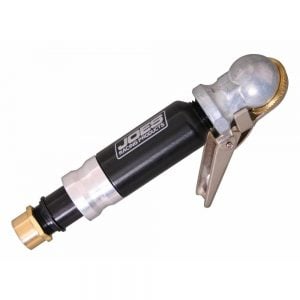 Purging air out of your tires and replacing it with nitrogen will remove moisture resulting in consistent stagger throughout the race. This purge tool has a slide collar to “dump” air quickly through fast flow ports that can be used when your tire specialist is attending to the tire. The collar slides to the closed position and a bleed valve prevents air and unwanted atmospheric moisture filled air from re-entering the tire during the purging process allowing your specialist to work on many tires at once. Top teams use multiple purge tools. The purge tool clips on the Schrader valve and automatically adjusts your tire to nearly any pressure allowing your crew to multitask with confidence.
Purging air out of your tires and replacing it with nitrogen will remove moisture resulting in consistent stagger throughout the race. This purge tool has a slide collar to “dump” air quickly through fast flow ports that can be used when your tire specialist is attending to the tire. The collar slides to the closed position and a bleed valve prevents air and unwanted atmospheric moisture filled air from re-entering the tire during the purging process allowing your specialist to work on many tires at once. Top teams use multiple purge tools. The purge tool clips on the Schrader valve and automatically adjusts your tire to nearly any pressure allowing your crew to multitask with confidence.
Nitrogen works well. Top teams have used Argon in their tires to further reduce moisture content. Argon and medical grade nitrogen produce such a small moisture reduction benefit that it is not worth the added cost. Dave Juarez states, “I have tried Argon and some other types of Nitrogen. Medical Grade Nitrogen was believed to be the preferred type but I did some research and found out that the only reason it is classified as “Medical” is the way in which the tanks are cleaned and filled. The chemical make-up is the same so there is no advantage within the tire”. Basically, Dave thinks standard nitrogen is a good economical choice.
Clipping on a purge tool to several tires allows tire specialists to replace moisture filled air with clean and moisture free nitrogen in record time. This purge tool clips on and can be set to very low PSI, preventing atmospheric pressure from re-entering the tire. The clip-on feature allows the tire specialist to set race pressures by adjusting the bleed valve, from very low, to maximum race pressures. Top teams have several purge tools clipped onto multiple sets of tires. On hot days, the clip on feature, allows teams to automatically bleed off pressure created by heat build up from the sun.
Joe Constance takes a practical approach and takes care to keep water out of the tire during the mounting process, Joe explains, “Keeping water out of the tire during the mounting process is a big deal. If you are not careful you can get a bunch of mounting soap and water in one tire and half as much in another. I like to use WD-40 for mounting tires. WD stands for water displacement. The WD-40 lube is slippery enough to mount the tire and you can keep the tire sized right by avoiding using water all together”.
Tire Gauge
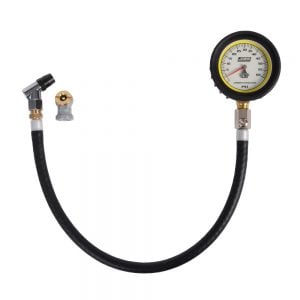 Using a top quality pressure gauge fine tunes your stagger with optimal pressure. This gauge comes complete with an angled chrome chuck and a ball chuck ensuring it works in every application. You always have the right gauge and can avoid worrying about being committed to one style of chuck. Racers can change out the chuck in thirty seconds as, for this gauge, the chuck threads on so teams can change as needed.
Using a top quality pressure gauge fine tunes your stagger with optimal pressure. This gauge comes complete with an angled chrome chuck and a ball chuck ensuring it works in every application. You always have the right gauge and can avoid worrying about being committed to one style of chuck. Racers can change out the chuck in thirty seconds as, for this gauge, the chuck threads on so teams can change as needed.
Air Dryer
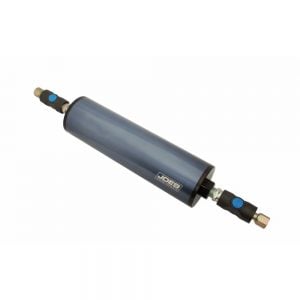 Juarez says, “I have used air dryers, desiccant moisture removers, clean nitrogen and so on but the most benefit is gained by having a consistent plan”. Depending on conditions, I purge the tires with nitrogen a minimum of 2 times but generally would prefer to use a humidity gauge and purge the tires as dry as possible. Usually it is 4-5 purges that are needed to purge down to a “zero” state – well near zero”. Dave continues, “If I am mounting the tire, I use the least amount of tire “soap” or mounting medium. When I seat the bead I use compressed air that goes through a dryer first”. Dave goes on, “you can create some stagger starting your right side air pressures slightly higher than “recommended” during your initial practice run on stickers but only if scuffs are allowed by your series on pit stops. When you run slightly higher right side pressures, the heat cycle in the tire will “hold” a bit more stagger.
Juarez says, “I have used air dryers, desiccant moisture removers, clean nitrogen and so on but the most benefit is gained by having a consistent plan”. Depending on conditions, I purge the tires with nitrogen a minimum of 2 times but generally would prefer to use a humidity gauge and purge the tires as dry as possible. Usually it is 4-5 purges that are needed to purge down to a “zero” state – well near zero”. Dave continues, “If I am mounting the tire, I use the least amount of tire “soap” or mounting medium. When I seat the bead I use compressed air that goes through a dryer first”. Dave goes on, “you can create some stagger starting your right side air pressures slightly higher than “recommended” during your initial practice run on stickers but only if scuffs are allowed by your series on pit stops. When you run slightly higher right side pressures, the heat cycle in the tire will “hold” a bit more stagger.
Personally (Jeff Butcher), my goal in managing tires is to work with the tires and not against them. For short track cars and sticker tires I always put 20 PSI in the lefts and 30 PSI in the rights – I made sure the guys at the tire truck didn’t over inflate them from my numbers as I wanted the tires to be in their natural state every week without crazy air pressures that produced variables. In my experience, consistency allowed for predictability. Artificially growing tires was a sure way to have the stagger change during race conditions. I did make sure water was kept out of the tires and I used standard nitrogen, medical grade simply was a cost item that didn’t equal the value. I purged the tires 2 times as that seemed to be the point where the most benefit was gained. Purging more than 2 times gained a little but it takes time and our hauler had a limit on how many heavy nitrogen bottles it could carry. We had a nitrogen sponsor but 2 times seemed to remove most of the moisture. Consistently purging 2 times each week was a “routine”.
I think the mistake that is made by many teams is that cold measurements, taken after stretching “tricks”, create dramatic size changes that disappear during/after a heat cycle. The tires are what they are based on how they were manufactured and to think you can stretch the sidewall seems like a “mental stretch” to me. Really, you would have to break down the side wall cords to grow a tire so in my view, high using high air pressures with the goal of making a tire bigger simply ballooned out the center of the tire for a short while and any stretch is a mirage.
Joe Constance says, “I have only used nitrogen but if you are going to slop a bunch of tire mounting goo with moisture in it on the bead before you mount it you might as well save some money and just use air from your compressor. It is very important to keep the inside of your tires as dry as possible”. Constance continues, “I am around a lot of teams that are on a budget and they may only have one nitrogen bottle – it would be nice to purge tires two or three times but they don’t usually have the time or money. Since many teams only carry one nitrogen bottle to the track, one purge becomes the max. As long as they are consistent they can usually calculate how much the pressure will grow”.
Matching sets, especially when you have multiple new sets, is part of the art performed a tire specialist. Dave Juarez states, “In a perfect world, the left sides would all be the same and the “average” would come from the right side tires”. Dave continues, “I try to match sets so you could switch left sides to add or deduct stagger on pit stops. I tend to lean toward using my Right Side tires to add or subtract stagger since the Right Side Tires take most of the load during a race. Most often, the 2-tire stop is right sides so having the option to switch tires around coupled with adding/removing air pressure is critical to handling and performance after a stop”.
Dave thinks, “Most of the pressures and tire sizing depends on your application or set-up. Most drivers can’t tell the difference in 1/8” of static stagger. During a run when the air pressure builds, the associated stagger change and air increase will have the greatest effect on handling. Pay closest attention to your “set” choices based on the set-up and handling of the car. If the Crew Chief and Driver are on the same page, it is far easier to “follow” and “manage” your available set options which is a big help in selecting sets for the race and qualifying. Nowadays, it is more important to keep your “brand” or serial numbers as close together as possible so your tire inventory comes out of the same batch creating added consistency.
Joe Constance says, “I love Saturday night racing and pit stop races are rare for the cars I have driven. The few pit stop races I have done were under budgeted with a limited crew and we made the best out of our hard working Bad News Bears volunteers. I had some knowledgeable long term faithful help but we often didn’t have enough manpower. Often, we had the track mascot or trophy girl changing the right rear tire on pit stops. I do know that you can feel a ¼” of stagger difference and even that small amount has a major effect on handling so know your tires is critical.
Joe continues, “Communication between the driver and crew is important and using different tire sizes to dial in the car can get you to the front. A well chosen stagger change can be huge. Making sure you know what tire sizes are on the car at all times helps you select the best set of rights or lefts and keeps the monkey in its mascot suit preventing your team from doing inappropriate things to a football.” (Joe said that quote a bit differently so I edited his words for the article – I am all sure you all can figure out what it looks like when teams do inappropriate things to a football after a Keystone Cops pit stop).
Constance believes, “I always try to get all the same size lefts, I vary the rights about a ¼” going off of the sizes marked on the tires when new because they are never exactly what they say they are and this gives me some adjustment during the race. I always try to keep the rear stagger the same and compensate for the wrong front stagger with other chassis adjustments. The goal is to have the best set for the end of the race. Only the last lap counts!
Dave Juarez, “I like to use a tire roller and I trust a tape measure more for precision. I will measure along the tire shoulder when the tire is on the ground when needed and easily get accurate and repeatable results. I also need a stagger tool as in our series we are not allowed to jack up the car post qualifying”.
Tire Specialist
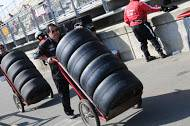 A quality tire specialist helps any team win. Tire experts are the hardest working people in the pits and need to react precisely to split-second decisions made by demanding crew chiefs. Top Cup Crew Chief, Shane Wilson, relies on JOES Racing employee Robert Osaki, flying him around the country for special events. Robert is well known for being the nicest person on the planet and is regarded as one of the best tire specialists in the business. Here, he is shown helping Gene Price Motorsports get their rubber to the road at Infineon Raceway in California.
A quality tire specialist helps any team win. Tire experts are the hardest working people in the pits and need to react precisely to split-second decisions made by demanding crew chiefs. Top Cup Crew Chief, Shane Wilson, relies on JOES Racing employee Robert Osaki, flying him around the country for special events. Robert is well known for being the nicest person on the planet and is regarded as one of the best tire specialists in the business. Here, he is shown helping Gene Price Motorsports get their rubber to the road at Infineon Raceway in California.
Tires are a big investment for any team and a good tire guy is invaluable. Just think about the last pit stop on a big TV race and how the tire guy can mess up the fastest car on the track by handing the tire changer the wrong size tire or one with incorrect air pressure? Managing and massaging tires is an art. JOES Racing Products employee, Robert Osaki, is known as one of the best tire guys in the business. Top teams such as Gene Price Motorsports and Kevin Harvick Industries fly Rob around the country, at great expense, because they can trust that he knows his tire stack inside and out. Rob’s knowledge, care and experience make him an asset to any team. To win races, your team needs a tire specialist that treats each tire like family. Find a cat like Robert Osaki and your car will always go on all fours.
